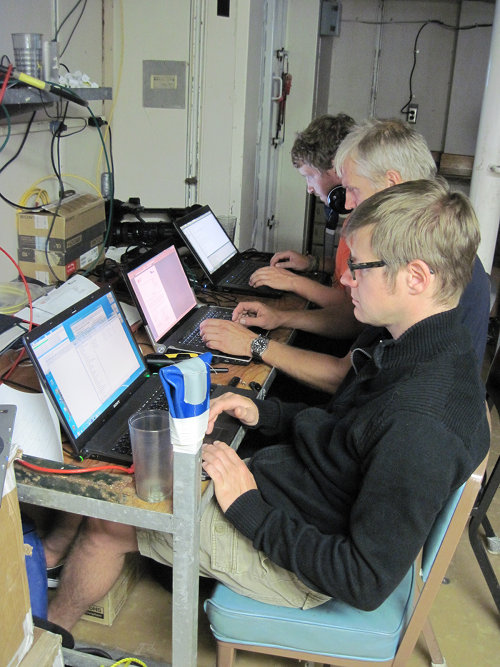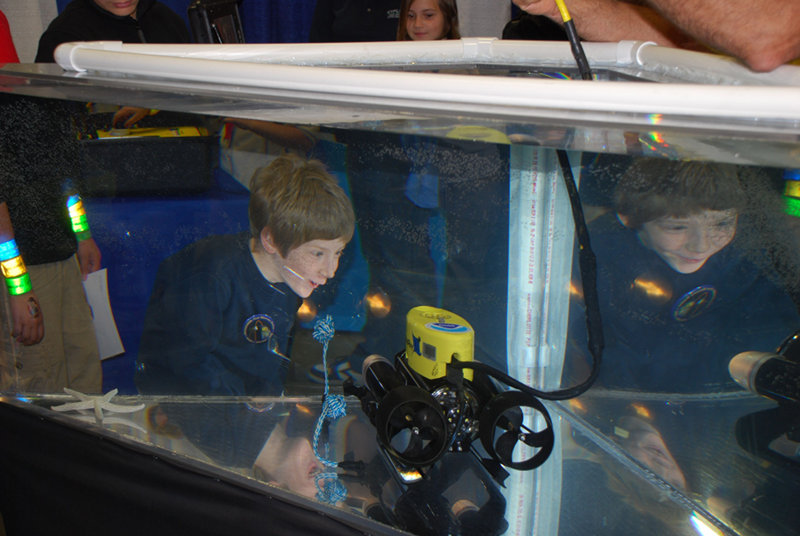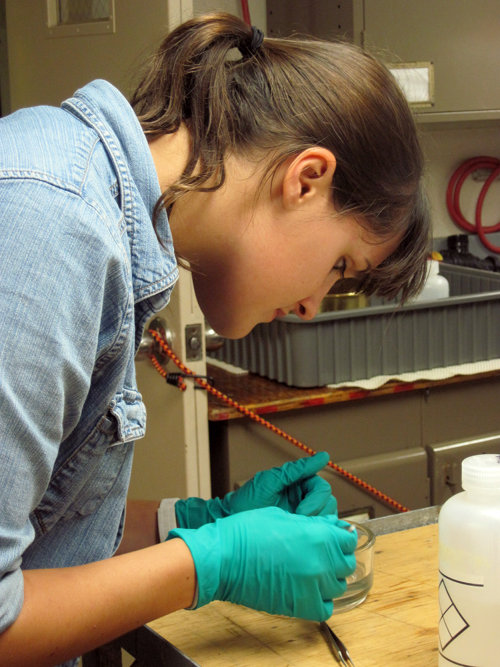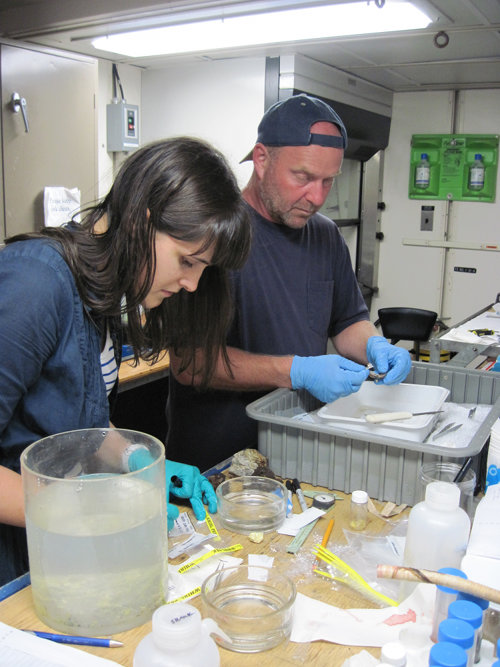
By Greg Engemann, ROV Pilot - MARUM
and Christian Reuter, ROV Pilot, Technician - MARUM
September 25, 2012
2343 GMT
Wind – NNW @ 4 kts
Air Temperature – 26.7° C (82.9° F)
Sea State – 3.1m
On a typical workday for us on other cruises, the time we spend flying a remotely operated vehicle (ROV) can be boring. We begin our day by cramming three to five people in a 20-foot container van along with many computers, monitors, and power conditioning equipment. Our job for the day is to follow pipe that has been placed along the seafloor, or worse, watch it touchdown as it is lowered from the surface. Although this might sound exciting for some, 12 hours watching a pipe coming to rest on the sediment at the bottom of the sea can get monotonous, and it is quite easy.

ROV pilots work from video science lab to communicate with pilots in ROV control van on the deck of the R/V Roger Revelle. Image courtesy of Submarine Ring of Fire 2012: Northeast Lau Basin, NOAA-OER. Download larger version (jpg, 2.0 MB).
Flying an ROV on a research vessel certainly doesn’t fall into this category. First, you meet ships in exotic ports where you can imagine what the world was like decades ago. This time, it’s Fiji –a place most of us would never be able to visit were it not for our job. True – we only have a few days in harbor, however it gives one a sense of adventure few other jobs nowadays can offer. Operating the ROV to explore the ocean is different than using it to observe pipe on the ocean floor. Just before the first deployment of the ROV in the water, and again after each mobilization of the ROV for each consecutive dive site, everyone holds their breath and keeps their fingers crossed. Was everything set up correctly?
We are using a combination of proven industrial gear, custom-developed tools and controls, scientific sensors and collecting equipment along with the unbound curiosity of the scientists to attain our exploration goals. It is essential that we all talk to each other to ensure the effective operation of everything from custom written computer programs that must be compatible with the ROV control system to ensuring all of the sampling equipment is set up in such a way that it doesn’t affect the performance of the ROV. This can be overwhelming at times, always challenging and deeply satisfying when it all comes together.

“Wow!” is the word at the 2012 USA Science and Technology Festival in Washington, DC. Image courtesy of Submarine Ring of Fire 2012: Northeast Lau Basin, NOAA-OER. Download larger version (jpg, 2.8 MB).
Working with the ROV on the seafloor is just breathtaking – seeing things that possibly no one else has ever set eyes on, collecting samples that might someday bring us a small step closer to understanding the mystery of our planet. One feels a strong sense of purpose collecting samples, taking measurements, and documenting this on video - another rarity in our typical day-to-day work routine.
No one is just an ROV pilot. It is necessary to be an electrical technician, mechanic, inventor, and programmer and all-around improviser. You have to be able to clearly focus on the task at hand even after just a few hours of sleep and be able to make the right decisions quickly. To us, it is the best job in the world – a little boy’s dream come true.
By Anabel Martinez, Undergraduate Student - King's College London
September 25, 2012
I’m currently a Molecular Genetics B.Sc. student at King’s College London, and wanted to get some hands-on experience in a lab while visiting my family this summer in the States. I started in Tim Shank’s Lab at Wood’s Hole Oceanographic Institution (WHOI) in July to learn some of the techniques and methods including DNA extraction and purification. During my last few weeks Tim invited me to join the cruise here in the Lau Basin to explore some of the biological diversity in this extremely volcanic area: it was a no-brainer!

Anabel Martinez prepares for samples to arrive in the lab from the ROV dive. Image courtesy of Submarine Ring of Fire 2012: Northeast Lau Basin, NOAA-OER. Download larger version (jpg, 1.4 MB).
Now I’m aboard the R/V Roger Revelle with the science party and crew as we continue conducting remotely operated vehicle (ROV) dives and CTD casts at the Lau Basin in the Southwestern Pacific. I’ve enjoyed every day so far, and am learning more and more as the cruise continues.
My general routine is wake up at 9:00 a.m., watch the ROV dive begin, do image-analysis of pictures from dives from the last Lau Basin cruise, sleep until I have to collect samples when the ROV re-surfaces, and then start a night shift at 9:00 p.m. until 5:00 a.m. assisting with the CTD water-filtering system. Each day is slightly different and I’m never sure what I’ll do, see or learn, but mostly I just enjoy conversations with scientists exploring particular areas of ocean geology, chemistry or microbiology.
One of the highlights of my trip so far was recovering and recording samples from the Fonualei South Volcano. During the day of September 13th, the ROV explored the seafloor and found both a sulfide tower and a new hydrothermal chimney field. From these locations the ROV collected a manganese oxide-covered mussel shell, a hairy snail, a crab, and about 70 small shrimp, but it was not until about 9:00 p.m. that the ROV was brought onboard and we could check to see if everything had stayed inside the sample chambers. It was really exciting to go out on deck at night holding buckets filled with seawater, waiting for the ROV to be secured, ready to rush the samples into the refrigerated cold-room to keep their DNA and structures intact. The recording process took a few hours as we photographed, gave preliminary species IDs to, and preserved the various samples. Several of the other scientists and crew came to look at the animals that they had seen collected by the suction sampler earlier on the many video monitors placed throughout the ship.

Anabel Martinez and Dr. Tim Shank (Woods Hole Oceanographic Institution) process samples after collection by the ROV. Image courtesy of Submarine Ring of Fire 2012: Northeast Lau Basin, NOAA-OER. Download larger version (jpg, 1.3 MB).
Seeing the process of planning the dive location, waiting for the ship to navigate to the site, watching the ROV enter the water and explore the seafloor, and then, at the end of that day, be able to hold a crab from 1500 or so metres depth was brilliant from start to finish. That kind of excitement, from exploring a part of the world that very few have seen, is what got me interested in science in the first place, and what makes me continue to seek experiences like this.
Lastly, my advice for any first-timers on an ocean exploration or research cruise is to accept any invitation that comes your way, and ask questions about the things you don’t understand because there is probably an expert on the subject one or two rooms over. From following this ideology, I’ve learnt about how ‘black smokers’ are formed by the build-up of metal precipitates, seen olivine droplets in a porous volcanic rock, and been able to get involved with the water-sampling CTD deployment, logging, and recovery.
I’m extremely thankful for this opportunity to be surrounded by scientists who have been so willing to let me understand and get involved with their work. I’m looking forward to the last week as we dive near the Mata volcanoes: let’s see what we can find!